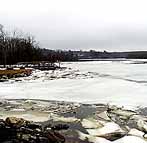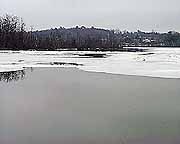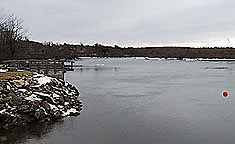Sagadahoc Stories #84: 3/21/99
Portents
| This week was Ice Out. The river opened up in stages after last
weekend's snow storm, but seemed determined to stay blocked until
the equinox. The last of the stuck ice let go at Cathance Landing
Wednesday, but it was so jammed at the first turn there was no
open water to Brickyard Point. You have to be able to row a boat
from the landing to the point for Ice Out to be official. With
$150 in the pot and the Cathance crown in dispute, we were all
watching eagerly. |
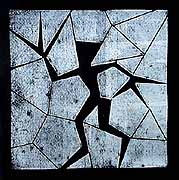
Ice Out
|
Brent came and got me Thursday evening at last light for a second
opinion. The Cathance was clear as far as you could see from the
landing, but a dense fog obscured the bend, and we hiked along
the tracks to the double bridges, trying to read the river. Too
dark and too thick to tell. We decided if there was an ice jam
in the morning it wasn't official, yet.
Packed flows still clogged the way Friday morning. Everyone in
the pool seemed to find a reason to swing through the landing
lot during the day, and the making tide brought hunks of ice bobbing
and wheeling back upstream. The tide topped out just before sunset,
and the last ice went out in a rush at dusk. Friday's the winner.
| The week was full of promising signs. Starlings, grackles, and
a few redwing blackbirds are making noises in the bare trees.
A raft of ducks set down in the open river, and the odd canard
flogged the air. Ladybugs are on the move indoors, creeping everywhere.
Daffodils are nosing up, and we have crocuses opening by the doorstep. |

|
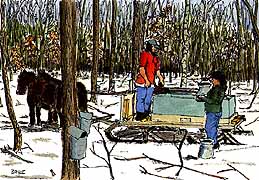
Sugaring
|
The deep snow we were stomping through on Sunday was down to our
ankles by mid-week, and a combination of cold nights and warm
days made the sap jump. I went over to Mitch's Tuesday morning
to lend a hand in the sugarbush and take some pictures. He and
Penny are straight out sugaring, and it was a rush to go and play
in the woods. |
| Mitch has four collection operations going. A widespread string
of roadside taps he empties into his bulk tank on the pickup,
250 taps in his own woodlot which he collects by mansweat and
horsepower, a tubed operation in a neighbor's lot which gravity
feeds into a tank he off-loads with his team, and another neighbor's
lot that the neighbor helps him collect by hand into the truck
tank. When I got there Mitch was just putting the harness on his
horses. |
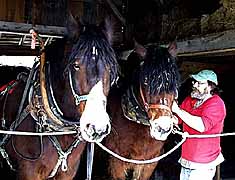
|
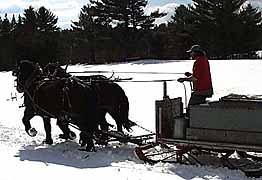
|
The horses were obviously eager to get out and work. No sooner
had he hitched up the sled than they stepped out in anticipation.
Mitch had to keep woahing them repeatedly at every stop, they
were so hot to trot. We slid the galvanized sap tank from the
wagon to the sled, whistled up the dogs, and broke trail for the
bush. Penny and I hung on for dear life as the sled careened and
plunged along the woods road. The frost has gone out of the ground
in places, and the road isn't real even to begin with. |
| Out in the sugarbush the snow was deep slop, and lugging pails
from tap to tap was wet low comedy. Every step or two you'd stumble
over buried branches, trying not to spill sap, or take a header.
Mitch is using new spiles which are smaller and less destructive
than earlier versions. They also mean you can double up on smaller
trees, and the combined run had many collection pails overflowing.
The broad-lipped carrying pails got heavy all too quickly. |
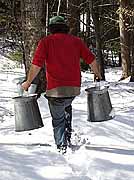
|
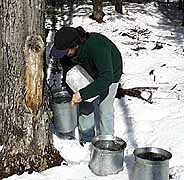
|
The three of us fanned out and wove together as the horses stopped
and stamped and started along a serpentine trail. I shucked out
of my sweatshirt, and was dripping in the dappled sunlight. Shirtsleeve
weather. Set down the carrying pail, remove the tin cover on the
collection bucket, unhook it, pour the sap, rehook the bucket
with the feed lines inside, recover it, pick up the pail, stumble
on, and repeat. It didn't seem long at all before we'd made the
circuit, and all 250 taps were serviced. 350 gallons of sap. Maybe
make 5 gallons of syrup. |
Penny and I legged it out behind the sled. Mitch hooked up the
transfer pump, and lifted the sap up into the overhead tank in
the saphouse. Then he and I rode the sled through the woods to
the tubed operation. A very different scene. Like some high-tech
silvaculture ward, where the trees are getting intravenous. A
spider web of multicolored tubing stretched along taut wires converged
on another saphouse, filling a massive stainless bulk tank. When
Mitch lifted the lid he whistled. It was brimming full, and would
take two trips with the horses to transfer.
|
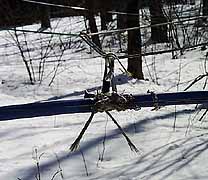
|
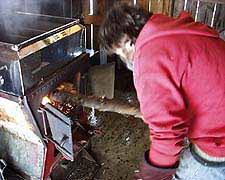
|
Back in the saphouse Mitch fired up the evaporator and began to
boil off. Between the buckets and taps and tanks and tubes and
saphouse and evaporator and all, sugaring is very capital intensive.
And it takes plenty of man hours to make maple syrup, too. Add
that to the erratic nature of the work.. the fact that you rush
like a crazed thing when the sap is running, but can never be
sure when it will run.. and you can understand why so few operators
are sucking up to this "free" bounty. |
Mitch is all excited about his new equipment this year. He has
a pumped separator filter that takes the mung out of the sap before
it goes into the evaporator, and makes everything run smoother.
The big new evaporator hood works like a charm, and all the tools
for the small details are at hand. He started to fire up the works.
I didn't stay for the syrup to thicken, having dropped in on other
days when the evaporator was in full steam, and when he was tapping
finished syrup out of the pasteurizer.
|
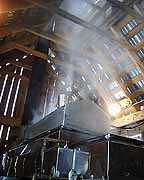
Photo Essay
|
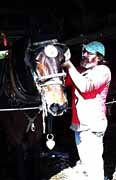
|
Mitch is one of the finest painters I know. Academy trained and
moderately successful in his first years working in oils, he simply
couldn't stand the art business. Promoting yourself to dealers
and patrons. Being dependent on the whims of a faddish market.
He'd rather shovel horse manure, and suck on tree sap. So he does.
Subsistence agriculture isn't too different from being a starving
artist, and you get to talk to the horses.
|
| With all these signs of Spring in the air, I indulged in a seasonal
ritual myself. Making lawn ornaments. A couple in a small pickup growled up the driveway last Saturday
week, and the lady got out to ask if I was selling any robins
this year. I averred it was possible, and she order a trio. Two
uprights, right and left, and a wormer. So I broke out the sabersaw
and the MDO board, and lined out 8 birds. I needed to replace
those of Peggy's I sold last year, anyhow. Fire up the robin factory. |
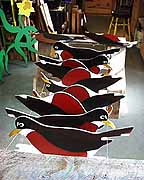
|
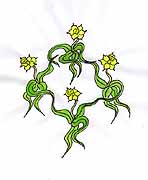
Dancing Daffs
|
I'd already made a start on some dancing daffodil ornaments, a
vision I'd seen months back, but had been waiting the proper season
to realize. The smell of plywood glue and sawdust, acrylic and
varnish, sweetened the air in the Eagles. I also worked the dancing
daff sketches into a drawing for a notecard. I'd originally seen
the image as a woodblock design, and had other equinoctial visions
I'd sketched out in collage to carve, but this puter printing
makes cutting woodblocks even more antiquated, and I settled on
scanning and printing. There's something viscerally satisfying
about cutting a picture into a board and pulling a print off it,
but this week I took the short road, and the ornamental way. |

Equinox
|
The ornamental urge is a seasonal imperative, and this Spring
we have another case of Steeple Fever in town. The Second Baptist
Church called in a crane on Thursday, and proceeded to lift its
lid for renovations. What with the Town Hall and The Reverend
Dan's church having replaced their superstructures last year,
the 2nd Baptists could do no less.
The crane outfit spudded down behind the church and proceeded
to make three false tries of yanking the steeple off. It may be
old and rotten (it's reportedly the original belfry from 1820),
but it was simply too heavy to budge. The contractors had to shift
their ground so the crane was more vertical, do some more chainsawing
and ripping, and cross their fingers, before the old cap tore
away. They lowered it carefully onto the driveway, where it immediately
disintegrated. A replica, with a hidden pitched top for drainage,
will replace it. (See photo Essay.) |
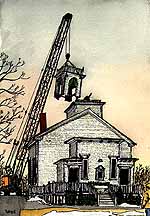
Steeple Jacking
|
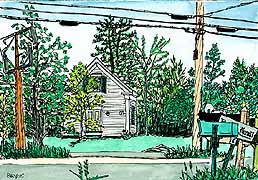
First Baptist Church (last Spring)
|
Jawing with Pastor Reed at the curb, we got a smattering of church
lore. The History of Bowdoinham I'd just read reported that the
schism which split the original Baptist congregation in town had
been occasioned by a dispute over missionizing. Some said missionizing
wasn't true doctrine, while others believed it was essential.
The non-missionizers up and walked, to build a church at the corner
of the Brown's Point Road, taking the First Baptist name with
them. The Baptist Missionary Society stayed put, and became the
Second Baptist Church. Pastor Reed said he thought the split was
actually over paying the parson. Until that time a visiting minister
on circuit served the congregation, and wasn't paid. I was delighted
to find that the pastor understood fine doctrinal distinctions.
|
One of the workmen called down that there was a date on the bell.
1898. It won't be ringing over the village on Sunday mornings
for a while, but the plaster won't be falling on the congregation
either. It was a raw gray day with intermittent sunshowers, and
I was glad to have my hat on as I walked back to Brooklyn.
|
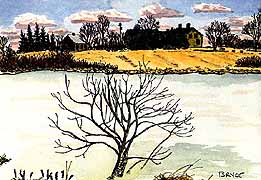
Frank's Pond
|
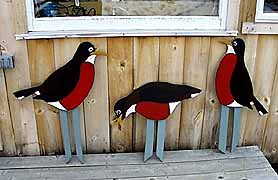
|
Capt. Ken dragged me out of the robin factory on Friday to spend
a couple hours at the Maine Boatbuilders' Show. A collection of
gorgeous vessels and fascinating faces. Lined mugs and hard hands
mingled with fashionable downdressing and excess incomes. The
place was mobbed, and the nearby Munjoy Hill neighborhood was
full of upscale autos with Mass and Conn plates. I bumped into
some of the usual suspects. My ambition was to get some suggestions
about details for this square-toed frigate I'm contemplating,
but whenever I'd say the word "scow" to a boatbuilder he'd look
at me cock-eyed. If there's anything that'll convince me to sail
in a box it's a righteous sneer. Is this like shoveling manure?
|
I found the well-heeled crowding at the show oppressive, even
though the smell of tarred cordage and boat paint in the old waterfront
warehouse was evocative. There's something about turning workmanlike
trades into designer artforms, and old lofts into boutiques, that
makes me nervous. This may be a form of self-loathing, of course.
What could be more gentrified than art toymaking? So I'll probably
build a 19th Century scow to spite my face.
There was a booth at the show promoting the building of a replica
of VIRGINIA, the first ship constructed from scratch on these
shores. Although the Popham Colony didn't survive beyond its first
winter, the 45 foot pinnace the colonists got out of the local
woods went on to sail up and down the coast, carrying truck between
Maine and Virginia. I chatted up the promoters, and was delighted
to see that the model they have shows her rigged with a spritted
gaff (?) sail, loose footed. I've been thinking about using that
rig, and here's another rationalization to do so. What could be
more in the local tradition than the rig of the first native boat?
|
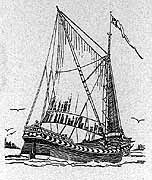
|
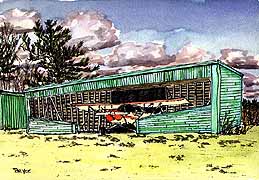
Hangar
|
We sailed back to Bowdoinham with a headful of absurd notions,
and an armload of catalogs. Spring is sprung. The moon is new.
I've installed a raised walkway to the Eagles. CC has found a
collection of snow-buried balls. Peggy is losing her frog. Planes
are coming out of the hanger. Wooden daffs are dancing on the
front lawn. What more could you ask for? Happy Spring. |
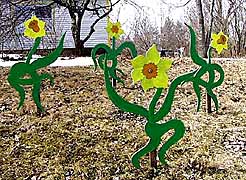
Dancing Daffs

